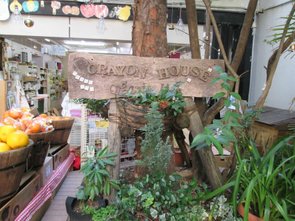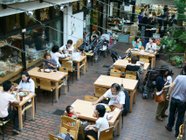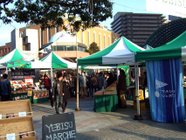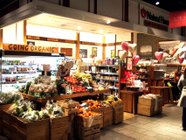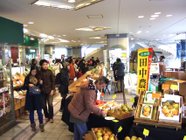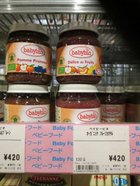While the growth of organic agriculture is still moderate, the demand for organic products has been continuously increasing since the big earthquake and subsequent disasters in March 2011.The Japanese market is next to China still the largest in Asia and has a big potential, especially if natural and organic non-food products are included. According to recent surveys and estimates the current total volume of domestic and imported organic products represents a value of about JPY180 bn (approx. US$1.8 bn). These are impressive figures, even though they present only a fraction of the total market for conventional food and beverages.
(Picture: Tokyo: The Crayon House´s offer includes food and non-food)
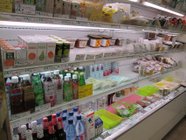 Until now the demand and market for organic products in Japan has been increasing at a slower pace than in Western and some Asian countries. Major obstacles are a limited range and variety of available products in supermarkets and other shops and especially the comparatively high prices. With few exceptions organic products, whether from domestic production or imported, are 2-3 times more expensive than comparable conventional products. This is similar in other Asian countries and quite different from Europe and North America where the price gap is much smaller (approx. 20% – 30% depending on the product), so organic products are affordable for people with an average income. (Picture: a limited range and high prices are major obstacles for organic products in Japan)
Until now the demand and market for organic products in Japan has been increasing at a slower pace than in Western and some Asian countries. Major obstacles are a limited range and variety of available products in supermarkets and other shops and especially the comparatively high prices. With few exceptions organic products, whether from domestic production or imported, are 2-3 times more expensive than comparable conventional products. This is similar in other Asian countries and quite different from Europe and North America where the price gap is much smaller (approx. 20% – 30% depending on the product), so organic products are affordable for people with an average income. (Picture: a limited range and high prices are major obstacles for organic products in Japan)
This unfortunate situation will only change if and when major food companies and retailers go organic and offer a larger variety of organic products. There are already some indications that this will happen in the not too distant future. A major reason and motivation for both producers and consumers is the growing concern about safe food and reliable sources for raw materials. As Japan will always depend on a large share of imported food – conventional and organic – it must avoid international critic and problems resulting from unreasonable restrictions in food imports. Recent negotiations and agreements, such as the Trans-Pacific-Partnership (TPP), equivalence agreements of organic products with the EU (since 2010) and the USA (starting from January 2014) are pointing into the right direction. (Picture: mega cities like Tokyo the demand for organic products is high)
As a result of the earthquake and even more because of the accidents in the nuclear power plants and resulting in radiation and destruction of a large agricultural area, the awareness and demand for safe and healthy organic products has increased. Nowadays, not only small and specialized shops, but also chain stores and supermarkets are offering a wider range of organic products. This trend is gradually spreading from stores downtown areas with more affluent customers to outskirts and other areas where ordinary housewives are shopping. Some high-end supermarkets, such as Kinokuniya have more than 200 domestic and imported organic products on their shelves. (Picture: consumers enjoy an organic meal in Crayon House restaurant)
(Pictures from left: organic food at a market, a specialized organic shop and at a chain store)
Selling organic farm products and their distribution is quite complicated and costly, resulting in high retail prices. The traditional Teikei-System (directly from producers to consumers) is still functioning, but nowadays combined with or absorbed by big consumer cooperatives based on membership (see graph below), such as Daichi Mamorukai, Radish Boya, Osisix and others. These organizations have many members and a big turnover. They focus on domestic organic products but also offer imported products as well as organic products not certified by JAS and other natural products. Another huge consumer cooperative is Seikyo which includes the Seikatsu Club and many regional chapters. Seikyo offers a wide range of “healthy” products including several thousand natural and organic items.
| Coop Name | Members | Turnover in US$
2012/13 |
| Daichi | 95,000 | approx. 132 mio. |
| Oisix 75,000 | 75,000 | approx. 145 mio |
| Radish Boya | 107,000 | approx. 220 mio |
| Seikatsu Club | 300,000 | no data available |
(Graph: cooperatives are a widely spread system. Not all buyers are members, so the actual number of customers is much larger)
In recent years the organic movement has spread all over the world, and organic products have moved out of a small niche for environment- and health-conscious consumers into the main stream. Nowadays such products are available in many shops and the interest of consumers is growing continuously. In spite of this development the networking in the organic world is still limited and insufficient in many respects. The internet provides a lot of information about products, manufacturers, distributors, as well as about the movement, associations, organizations and media. However, finding an overview, practical information and links to other sources with the required contents remains difficult. The portal Global Organic Network (GON) aims at closing this gap and connecting a wide range of organizations, producers, distributors, consumers, media, services etc. from different countries and regions. (Picture: GON web portal aims to networking)
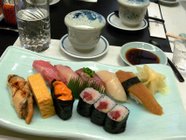 In the first GON project, the focus is on Japan: the market and selected products. Japanese food enjoys a high reputation and is popular all over the world. Traditional Japanese cuisine (Washoku) – from everyday dishes to luxurious menus – was added in December 2013 to the UNESCO intangible Cultural Heritage list. At the Japan Pavilion in hall 2-211/ 311 at BioFach, you can find a selection of organic food and beverages, and through GON many more from Japanese farmers and other companies interested in exporting their products.
In the first GON project, the focus is on Japan: the market and selected products. Japanese food enjoys a high reputation and is popular all over the world. Traditional Japanese cuisine (Washoku) – from everyday dishes to luxurious menus – was added in December 2013 to the UNESCO intangible Cultural Heritage list. At the Japan Pavilion in hall 2-211/ 311 at BioFach, you can find a selection of organic food and beverages, and through GON many more from Japanese farmers and other companies interested in exporting their products.
Domestic production cannot meet the growing demand – for more volume and variety – and until now very few of the major Japanese food processors are offering organic products. This may change eventually, resulting in more imports of organic raw materials, and big retailers with many shops will also offer more organic food and non-food products. Overall this means that imports will continuously increase, offering good opportunities for foreign producers and exporters. At a recent seminar about Organic Agriculture in Japan one of the participants proposed a project “Organic food at the Tokyo Olympics” and in Olympic villages. This idea was supported by other participants, but it will take some time to get approval and support from relevant organizations and the government. If this project goes ahead, GON will probably handle international PR. (Graph below: area of organic farms as of 2010. A small fraction of the total agricultural area is cultivated by a rather large number of organic farmers)
| Year | 2006 | 2007 | 2008 | 2009 | 2010 | Notes |
| Organic farms total | 8,764 | 10,045 | 10,981 | 11,323 | 11,859 | Slow but steady increase |
| Organic JAS
certified |
2,258 | 3,319 | 3,830 | 3,815 | 3,994 | |
| Changes compared with previous year | 114,69% | 109,3% | 103,09% | 104,7% | steady |
| Organic Agriculture | Agriculture total | % of total area |
| 16,000 ha | 4,611,000 ha | 0,4% |
| Organic JAS certified | 9,000 ha | 0,2% |
| without Organic JAS | 7,000 ha | 0,2 % |
 A major reason for the former stagnation of the organic market in Japan is the general lack of awareness about organic products among Japanese consumers. More than 12 years after its introduction Organic JAS is still not well and widely known, and the government has not made enough effort to improve this situation. The scope of products which can carry the Organic JAS label has been widened and now also includes organic livestock products and animal feed, but not yet fish and marine products. Furthermore, alcoholic beverages and most non-food products are not covered by Organic JAS, but nevertheless can be sold as organic in Japan.
A major reason for the former stagnation of the organic market in Japan is the general lack of awareness about organic products among Japanese consumers. More than 12 years after its introduction Organic JAS is still not well and widely known, and the government has not made enough effort to improve this situation. The scope of products which can carry the Organic JAS label has been widened and now also includes organic livestock products and animal feed, but not yet fish and marine products. Furthermore, alcoholic beverages and most non-food products are not covered by Organic JAS, but nevertheless can be sold as organic in Japan.
Japan more or less accepts organic products which have been certified according EU regulations (see picture). However, such products are still subject to Organic JAS regulations, a process which is time-consuming and expensive, before they can be sold on the market. Perhaps this will also change after the equivalency agreement with the USA. (Picture: the seal for organic Products JAS is not known very well)
Several divisions and sections within the Ministry of Agriculture, Forestry and Fisheries (MAFF) and associated outside organizations are dealing with food safety, organic products and related subjects. The government approved a budget to conduct an extensive survey about the organic production and market in Japan. MAFF started in 2010 a 3-year-project for the promotion of organic agriculture and products. In an effort to bring farmers/producers and buyers together, this project included a group pavilion at BioFach Japan.
While this project focused on the domestic market, another project – supported by MAFF and METI (Ministry of Economics, Trade and Industry) and organized by JETRO – is geared to the global market with participation at BioFach (2-211, 311) in Nuremberg. (Picture below: products at the BioFach Japan gain a lot of interest)
In the global context Japan is ready for organics. The future of organic products mainly depends on the choice of consumers. More (and cheaper) imports will provide a wider range of products as well as raw materials for processing in Japan. Some organic products, such as tea, soy sauce, sake and more, also find buyers abroad in spite of higher prices. In cooperation with IFOAM Japan and other experts ABC Enterprises prepared the (probably) first comprehensive English report of the Japanese organic market. This report is based on the Japanese version published by IFJ in 2010 plus an appendix with additional articles and information about the earthquake disaster in March and the aftermath.

